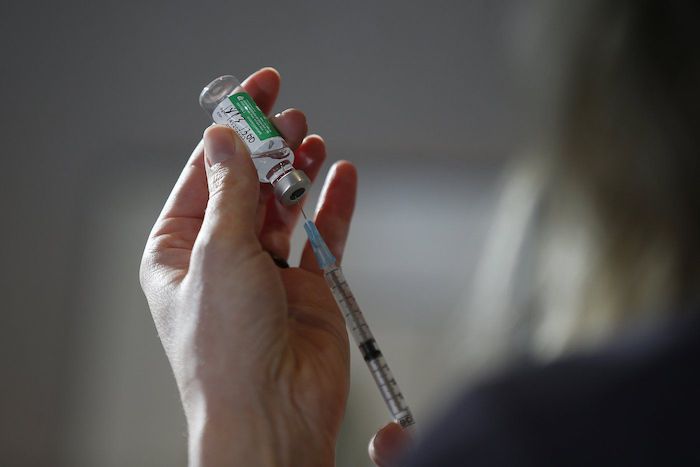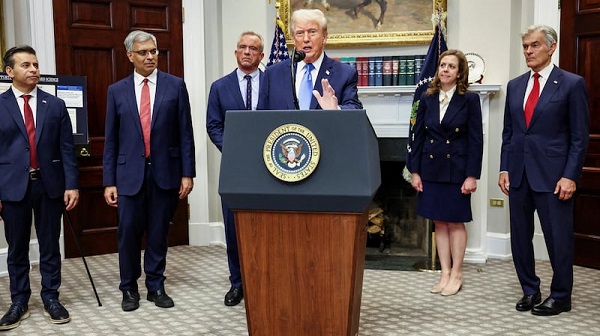Brownstone Institute
Had You Known, Would You Have Taken the Jab?

From the Brownstone Institute
” the company skewed the public debate in order to induce Americans to take its shots. The efforts stripped us of the right to informed consent, deceiving us on purported benefits while hiding established risks “
Would 92% of American adults have gotten a Covid shot had they known the “vaccines” only offered a 0.85% reduction in risk? Would young men have taken the jab if they had known it did not prevent transmission?
Americans came to understand that the media campaigns supporting the shots were fraudulent. The touted benefits – preventing infection and transmission – were lies. In response, fewer than one in five Americans elected to receive “boosters” despite multi-billion dollar propaganda campaigns.
Texas Attorney General Ken Paxton has now brought a suit to bring accountability for the fraud that resulted in record profits for the pharmaceutical industry. Paxton filed a complaint alleging that Pfizer misrepresented Covid vaccine efficacy and “conspired to censor public discourse” in violation of Texas’s Deceptive Trade Practices Act (DTPA).
While Big Pharma enjoys immense government-provided insulation from legal liability for vaccine injuries, it cannot lie to promote those products.
Paxton alleges that the $75 billion Pfizer has raked in through sales of Covid vaccines were the “direct and proximate result” of the company’s deceit.
The DTPA requires Paxton prove two questions to succeed in his case. First, he must establish that the company lied or failed to disclose known information concerning its Covid vaccine. Second, he must prove that the company’s fraud was designed to promote sales of the shots.
Brownstone previously analyzed the applicability of the DTPA against Moderna. Now, Paxton’s lawsuit threatens Pfizer with fines of $10 million as well as awards of “restitution, damages, or civil penalties.”
Paxton’s case argues that Pfizer deceived the public on three issues: (1) the efficacy of the vaccine; (2) whether the shots reduced the risk of transmission; and (3) the company’s efforts to “censor[] persons who threatened to disseminate the truth.”
In each instance, the company skewed the public debate in order to induce Americans to take its shots. The efforts stripped us of the right to informed consent, deceiving us on purported benefits while hiding established risks.
Efficacy
First, Paxton targets the now-familiar falsehoods that the company, led by CEO Albert Bourla, touted, including that the shots had “95% efficacy” and worked against mutations of the virus.
Paxton’s critiques do not require the benefit of hindsight. Pfizer’s own data showed that the vaccine was merely 0.85% effective in reducing the likelihood that an individual would contract Covid (known as absolute risk reduction). Put differently, Pfizer’s clinical data showed that “preventing one COVID-19 case required vaccinating 119.”
Despite this unconvincing data, Bourla claimed there was “initial evidence of our vaccine’s ability to prevent Covid-19.” Bourla later said that the shots had “100%” efficacy rates against mutations of the virus, including the Delta variant. Not only was this a lie, Pfizer never tested the shots against the variants. Still, in May 2021 he baselessly claimed that “no variant identified so far…escapes the protection of our vaccine.”
Three months later, the company issued a press release saying that boosters would “preserve and even exceed the high levels of protection against…relevant variants.” Shortly thereafter, the United States exercised its option to purchase 500 million more doses of Pfizer’s Covid vaccines.
These lies clearly and directly induced Americans to take products with illusory benefits. The claims were fabricated, and they led to billions of dollars in windfalls for Bourla and Pfizer.
Transmission
Pfizer’s marketing relied on convincing healthy young adults and teenagers to get shots despite the negligible risk that Covid posed to them. Bourla used transmission to launch a moral blackmail campaign. He told teenagers that they should get the shots to “protect…their loved ones.” He later tweeted, “widespread vaccination is a critical tool to help stop transmission.”
Under oath, company officials later admitted that they had never tested whether the vaccines reduced transmission.
In October 2022, Pfizer spokeswoman Janine Small appeared at a European Parliament hearing. “Was the Pfizer Covid vaccine tested on stopping transmission of the virus before it entered the market?” asked Dutch MEP Rob Roos. “No!” Small responded emphatically. “We had to really move at the speed of science to really understand what is taking place in the market; and from that point of view, we had to do everything at risk.”
Under the DTPA, Paxton must prove that the company misrepresented information regarding the vaccine in an effort to promote sales of its products. With the vast majority of Americans under 70 facing zero substantial risk from Covid infection, the lies regarding transmission were critical to expand the customer base.
This deception underpinned the mandates in 2021 as government and corporate officials insisted that vaccination was necessary to keep healthy adults’ coworkers and neighbors safe. By December 2021, Pfizer’s stock price had doubled from the onset of the pandemic in February 2020.
Censorship
As Pfizer committed to deceiving the public, it had to ensure that journalists would not uncover its corporate misdeeds. Paxton’s suit outlines how the company “sought to intimidate and silence…journalist Alex Berenson.”
As Berenson reported on the efficacy, or lack thereof, of mRNA “vaccines,” Pfizer Board Member Dr. Scott Gottlieb colluded with Twitter to silence his reporting. In August 2021, Berenson tweeted that Pfizer’s vaccine “doesn’t stop infection…[o]r transmission,” and had a“limited window of efficacy.” Despite the veracity of these statements, Gottlieb wrote to Twitter officials encouraging them to ban Berenson’s heresy.
Hours later, Berenson received a permanent ban (he was later reinstated following a lawsuit). Now, Pfizer CEO Albert Bourla is a defendant in Berenson’s case against the Biden Administration, which accuses White House officials of colluding with private actors in Big Tech and Big Pharma to usurp Berenson’s First Amendment rights.
Paxton’s case also outlines how Pfizer worked to silence scientists who discussed the benefits of natural immunity, calling the rhetoric “corrosive” to the public’s confidence in their products. The aim was simple: shield Americans from the truth so that they would continue to get the product.
A Rare Opportunity to Strike Back
To this point, “victories” against the hegemon that emerged in 2020 have been defensive in nature. Groups have fended off vaccine mandates, states have resisted calls for renewed lockdowns, and journalists have begun to expose the corruption that shattered Western civilization.
These efforts, though important, have failed to bring accountability against those who usurped our civil liberties and pillaged the national treasury. Paxton’s suit strikes at the heart of the corruption behind the Covid regime: how their success required mass deception and their profits depended on lies.
Though $10 million in fines is little compared to the $75 billion in revenue that Pfizer raked in from vaccines alone, the suit signifies that the resistance is at last on the offensive.
Big Pharma sees this is a grave threat, and its lobbying forces led a failed impeachment effort against Paxton this fall. They threw him out of his office, and disabled his ability to do his job that the voters sent him to do. Turning up nothing, the legislature rejected the entire drama. Now he is back and working and this is the result: accountability at last.
The steep drop in demand for Covid shots reveals how Pfizer depended upon fraud to promote their most lucrative product. Once Americans knew the truth, demand dropped by over 75%.
Now, Paxton’s suit brings that fraud to trial.
Autism
Trump Blows Open Autism Debate

From the Brownstone Institute
By
Trump made sweeping claims that would have ended political careers in any other era. His health officials tried to narrow the edges, but the President ensured that the headlines would be his.
Autism has long been the untouchable subject in American politics. For decades, federal agencies tiptoed around it, steering research toward genetics while carefully avoiding controversial environmental or pharmaceutical questions.
That ended at the White House this week, when President Donald Trump tore through the taboo with a blunt and sometimes incendiary performance that left even his own health chiefs scrambling to keep pace.
Flanked by Health Secretary Robert F. Kennedy, Jr., NIH Director Jay Bhattacharya, FDA Commissioner Marty Makary, CMS Adminstrator Dr Mehmet Oz, and other senior officials, Trump declared autism a “horrible, horrible crisis” and recounted its rise in startling terms.
“Just a few decades ago, one in 10,000 children had autism…now it’s one in 31, but in some areas, it’s much worse than that, if you can believe it, one in 31 and…for boys, it’s one in 12 in California,” Trump said.
The President insisted the trend was “artificially induced,” adding: “You don’t go from one in 20,000 to one in 10,000 and then you go to 12, you know, there’s something artificial. They’re taking something.”
Trump’s Blunt Tylenol Warning
The headline moment came when Trump zeroed in on acetaminophen, the common painkiller sold as Tylenol — known as paracetamol in Australia.
While Kennedy and Makary described a cautious process of label changes and physician advisories, Trump dispensed with nuance.
“Don’t take Tylenol,” Trump said flatly. “Don’t take it unless it’s absolutely necessary…fight like hell not to take it.”
Kennedy laid out the evidence base, citing “clinical and laboratory studies that suggest a potential association between acetaminophen used during pregnancy and adverse neurodevelopmental outcomes, including later diagnosis for ADHD and autism.”
Makary reinforced the point with references to the Boston Birth Cohort, the Nurses’ Health Study, and a recent Harvard review, before adding: “To quote the dean of the Harvard School of Public Health, there is a causal relationship between prenatal acetaminophen use and neurodevelopmental disorders of ADHD and autism spectrum disorder. We cannot wait any longer.”
But where the officials spoke of “lowest effective dose” and “shortest possible duration,” Trump thundered over the top: “I just want to say it like it is, don’t take Tylenol. Don’t take it if you just can’t. I mean, it says, fight like hell not to take it.”
Vaccines Back on Center Stage
The President then pivoted to vaccines, reviving arguments that the medical establishment has long sought to bury. He blasted the practice of giving infants multiple injections at a single visit.
“They pump so much stuff into those beautiful little babies, it’s a disgrace…you get a vat of 80 different vaccines, I guess, 80 different blends, and they pump it in,” Trump said.
His solution was simple: “Go to the doctor four times instead of once, or five times instead of once…it can only help.”
On the measles, mumps, and rubella shot, Trump insisted: “The MMR, I think should be taken separately…when you mix them, there could be a problem. So there’s no downside in taking them separately.”
The moment was astonishing — echoing arguments that had once seen doctors like Andrew Wakefield excommunicated from medical circles.
It was the kind of line of questioning the establishment had spent decades trying to banish from mainstream debate.
Hep B Vaccine under Attack
Trump dismissed the rationale for giving the hepatitis B vaccine at birth.
“Hepatitis B is sexually transmitted. There’s no reason to give a baby that’s just born hepatitis B [vaccine]. So I would say, wait till the baby is 12 years old,” he said.
He made clear that he was “not a doctor,” stressing that he was simply offering his personal opinion. But the move could also be interpreted as Trump choosing to take the heat himself, to shield Kennedy’s HHS from what was sure to be an onslaught of criticism.
The timing was remarkable.
Only last week, the CDC’s Advisory Committee on Immunisation Practices (ACIP) had been preparing to vote on whether to delay the hepatitis B shot until “one month” of age — a modest proposal that mainstream outlets derided as “anti-vax extremism.”
By contrast, Trump told the nation to push the jab back 12 years. His sweeping denunciations made the supposedly radical ACIP vote look almost tame.
The irony was inescapable — the same media voices who had painted Kennedy’s reshaped ACIP as reckless now faced a President willing to say far more than the panel itself dared.
A New Treatment and Big Research Push
The administration also unveiled what it deemed a breakthrough: FDA recognition of prescription leucovorin, a folate-based therapy, as a treatment for some autistic children.
Makary explained: “It may also be due to an autoimmune reaction to a folate receptor on the brain not allowing that important vitamin to get into the brain cells…one study found that with kids with autism and chronic folate deficiency, two-thirds of kids with autism symptoms had improvement and some marked improvement.”
Dr Oz confirmed Medicaid and CHIP (the Children’s Health Insurance Program, which provides low-cost health coverage to children in families that earn too much to qualify for Medicaid) would cover the treatment.
“Over half of American children are covered by Medicaid and CHIP…upon this label change…state Medicaid programs will cover prescription leucovorin around the country, it’s yours,” said Oz.
Bhattacharya announced $50 million in new NIH grants under the “Autism Data Science Initiative.”
He explained that 13 projects would be funded using “exposomics” — the study of how environmental exposures like diet, chemicals, and infections interact with our biology — alongside advanced causal inference methods.
“For too long, it’s been taboo to ask some questions for fear the scientific work might reveal a politically incorrect answer,” Bhattacharya said. “Because of this restricted focus in scientific investigations, the answers for families have been similarly restricted.”
Mothers’ Voices
The press conference also featured raw testimony from parents.
Amanda, mother of a profoundly autistic five-year-old, told Trump: “Unless you’ve lived with profound autism, you have no idea…it’s a very hopeless feeling. It’s very isolating. Being a parent with a profound autistic child, even just taking them over to your friend’s house is something we just don’t do.”
Jackie, mother of 11-year-old Eddie, said: “I’ve been praying for this day for nine years, and I’m so thankful to God for bringing the administration into our lives…I never thought we would have an administration that was courageous enough to look into things that no prior administration had.”
Their stories underscored what Kennedy said at the announcement about “believing women.” Here were mothers speaking directly about their lived reality, demanding that uncomfortable conversations could no longer be avoided.
Clashes with the Press Corps
Reporters pressed Trump on the backlash from medical groups.
Asked about the American College of Obstetricians and Gynecologists (ACOG) declaring acetaminophen safe in pregnancy, Trump shot back, “That’s the establishment. They’re funded by lots of different groups. And you know what? Maybe they’re right. I don’t think they are, because I don’t think the facts bear it out at all.”
When one journalist raised the argument that rising diagnoses reflected better recognition, Kennedy bristled,
“That’s one of the canards that has been promoted by the industry for many years,” he said. “It’s just common sense, because you’re only seeing this in people who are under 50 years of age. If it were better recognition or diagnosis, you’d see it in the seventy-year-old men. I’ve never seen this happening in people my age.”
Another reporter then asked Trump, “Should the establishment media show at least some openness to trying to figure out what the causes are?”
“I wish they would. Yeah, why are they so close-minded?” Trump replied. “It’s not only the media, in all fairness, it’s some people, when you talk about vaccines, it’s crazy…I don’t care about being attacked.”
Breaking the Spell
For years, autism policy has been shaped by caution, consensus, and deference to orthodox positions. That spell was broken at today’s press conference.
The dynamic was striking. Kennedy, Makary, Bhattacharya, and Oz leaned on scientific papers, review processes, and cautious advisories. Trump, by contrast, brushed it all aside, hammering his message home through repetition and personal anecdotes.
Trump made sweeping claims that would have ended political careers in any other era. His health officials tried to narrow the edges, but the President ensured that the headlines would be his.
“This will be as important as any single thing I’ve done,” Trump declared. “We’re going to save a lot of children from a tough life, really tough life. We’re going to save a lot of parents from a tough life.”
Whatever the science ultimately shows, the politics of autism in America will never be the same.
Republished from the author’s Substack
Brownstone Institute
Net Zero: The Mystery of the Falling Fertility

From the Brownstone Institute
By
If you want to argue that a mysterious factor X is responsible for the drop in fertility, you will have to explain (1) why the factor affected only the vaccinated, and (2) why it started affecting them at about the time of vaccination.
In January 2022, the number of children born in the Czech Republic suddenly decreased by about 10%. By the end of 2022, it had become clear that this was a signal: All the monthly numbers of newborns were mysteriously low.
In April 2023, I wrote a piece for a Czech investigative platform InFakta and suggested that this unexpected phenomenon might be connected to the aggressive vaccination campaign that had started approximately 9 months before the drop in natality. Denik N – a Czech equivalent of the New York Times – immediately came forward with a “devastating takedown” of my article, labeled me a liar and claimed that the pattern can be explained by demographics: There were fewer women in the population and they were getting older.
To compare fertility across countries (and time), the so-called Total Fertility Rate (TFR) is used. Roughly speaking, it is the average number of children that are born to a woman over her lifetime. TFR is independent of the number of women and of their age structure. Figure 1 below shows the evolution of TFR in several European countries between 2001 and 2023. I selected countries that experienced a similar drop in TFR in 2022 as the Czech Republic.

So, by the end of 2023, the following two points were clear:
- The drop in natality in the Czech Republic in 2022 could not be explained by demographic factors. Total fertility rate – which is independent of the number of women and their age structure – dropped sharply in 2022 and has been decreasing ever since. The data for 2024 show that the Czech TFR has decreased further to 1.37.
- Many other European countries experienced the same dramatic and unexpected decrease in fertility that started at the beginning of 2022. I have selected some of them for Figure 1 but there are more: The Netherlands, Norway, Slovakia, Slovenia, and Sweden. On the other hand, there are some countries that do not show a sudden drop in TFR, but rather a steady decline over a longer period (e.g. Belgium, France, UK, Greece, or Italy). Notable exceptions are Bulgaria, Spain, and Portugal where fertility has increased (albeit from very low numbers). The Human Fertility Project database has all the numbers.
This data pattern is so amazing and unexpected that even the mainstream media in Europe cannot avoid the problem completely. From time to time, talking heads with many academic titles appear and push one of the politically correct narratives: It’s Putin! (Spoiler alert: The war started in February 2022; however, children not born in 2022 were not conceived in 2021). It’s the inflation caused by Putin! (Sorry, that was even later). It’s the demographics! (Nope, see above, TFR is independent of the demographics).
Thus, the “v” word keeps creeping back into people’s minds and the Web’s Wild West is ripe with speculation. We decided not to speculate but to wrestle some more data from the Czech government. For many months, we were trying to acquire the number of newborns in each month, broken down by age and vaccination status of the mother. The post-socialist health-care system of our country is a double-edged sword: On one hand, the state collects much more data about citizens than an American would believe. On the other hand, we have an equivalent of the FOIA, and we are not afraid to use it. After many months of fruitless correspondence with the authorities, we turned to Jitka Chalankova – a Czech Ron Johnson in skirts – who finally managed to obtain an invaluable data sheet.
To my knowledge, the datasheet (now publicly available with an English translation here) is the only officially released dataset containing a breakdown of newborns by the Covid-19 vaccination status of the mother. We requested much more detailed data, but this is all we got. The data contains the number of births per month between January 2021 and December 2023 given by women (aged 18-39) who were vaccinated, i.e., had received at least one Covid vaccine dose by the date of delivery, and by women who were unvaccinated, i.e., had not received any dose of any Covid vaccine by the date of delivery.
Furthermore, the numbers of births per month by women vaccinated by one or more doses during pregnancy were provided. This enabled us to estimate the number of women who were vaccinated before conception. Then, we used open data on the Czech population structure by age, and open data on Covid vaccination by day, sex, and age.
Combining these three datasets, we were able to estimate the rates of successful conceptions (i.e., conceptions that led to births nine months later) by preconception vaccination status of the mother. Those interested in the technical details of the procedure may read Methods in the newly released paper. It is worth mentioning that the paper had been rejected without review in six high-ranking scientific journals. In Figure 2, we reprint the main finding of our analysis.

Figure 2 reveals several interesting patterns that I list here in order of importance:
- Vaccinated women conceived about a third fewer children than would be expected from their share of the population. Unvaccinated women conceived at about the same rate as all women before the pandemic. Thus, a strong association between Covid vaccination status and successful conceptions has been established.
- In the second half of 2021, there was a peak in the rate of conceptions of the unvaccinated (and a corresponding trough in the vaccinated). This points to rather intelligent behavior of Czech women, who – contrary to the official advice – probably avoided vaccination if they wanted to get pregnant. This concentrated the pregnancies in the unvaccinated group and produced the peak.
- In the first half of 2021, there was significant uncertainty in the estimates of the conception rates. The lower estimate of the conception rate in the vaccinated was produced by assuming that all women vaccinated (by at least one dose) during pregnancy were unvaccinated before conception. This was almost certainly true in the first half of 2021 because the vaccines were not available prior to 2021. The upper estimate was produced by assuming that all women vaccinated (by at least one dose) during pregnancy also received at least one dose before conception. This was probably closer to the truth in the second part of 2021. Thus, we think that the true conception rates for the vaccinated start close to the lower bound in early 2021 and end close to the upper bound in early 2022. Once again, we would like to be much more precise, but we have to work with what we have got.
Now that the association between Covid-19 vaccination and lower rates of conception has been established, the one important question looms: Is this association causal? In other words, did the Covid-19 vaccines really prevent women from getting pregnant?
The guardians of the official narrative brush off our findings and say that the difference is easily explained by confounding: The vaccinated tend to be older, more educated, city-dwelling, more climate change aware…you name it. That all may well be true, but in early 2022, the TFR of the whole population dropped sharply and has been decreasing ever since.
So, something must have happened in the spring of 2021. Had the population of women just spontaneously separated into two groups – rednecks who wanted kids and didn’t want the jab, and city slickers who didn’t want kids and wanted the jab – the fertility rate of the unvaccinated would indeed be much higher than that of the vaccinated. In that respect, such a selection bias could explain the observed pattern. However, had this been true, the total TFR of the whole population would have remained constant.
But this is not what happened. For some reason, the TFR of the whole population jumped down in January 2022 and has been decreasing ever since. And we have just shown that, for some reason, this decrease in fertility affected only the vaccinated. So, if you want to argue that a mysterious factor X is responsible for the drop in fertility, you will have to explain (1) why the factor affected only the vaccinated, and (2) why it started affecting them at about the time of vaccination. That is a tall order. Mr. Occam and I both think that X = the vaccine is the simplest explanation.
What really puzzles me is the continuation of the trend. If the vaccines really prevented conception, shouldn’t the effect have been transient? It’s been more than three years since the mass vaccination event, but fertility rates still keep falling. If this trend continues for another five years, we may as well stop arguing about pensions, defense spending, healthcare reform, and education – because we are done.
We are in the middle of what may be the biggest fertility crisis in the history of mankind. The reason for the collapse in fertility is not known. The governments of many European countries have the data that would unlock the mystery. Yet, it seems that no one wants to know.
Author
-

 National17 hours ago
National17 hours agoCanada’s birth rate plummets to an all-time low
-

 Crime16 hours ago
Crime16 hours agoPierre Poilievre says Christians may be ‘number one’ target of hate violence in Canada
-

 Alberta15 hours ago
Alberta15 hours agoJason Kenney’s Separatist Panic Misses the Point
-

 Automotive18 hours ago
Automotive18 hours agoBig Auto Wants Your Data. Trump and Congress Aren’t Having It.
-

 Aristotle Foundation2 days ago
Aristotle Foundation2 days agoEfforts to halt Harry Potter event expose the absurdity of trans activism
-

 Bruce Dowbiggin2 days ago
Bruce Dowbiggin2 days agoCanada’s Humility Gene: Connor Skates But Truckers Get Buried
-

 Energy2 days ago
Energy2 days ago“It is intellectually dishonest not to acknowledge the … erosion of trust among global customers in Canada’s ability to deliver another oil pipeline.”
-

 Energy2 days ago
Energy2 days agoIn the halls of Parliament, Ellis Ross may be the most high-profile advocate of Indigenous-led development in Canada.







